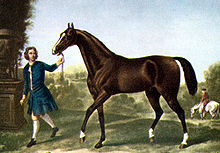Aldby Park
Aldby Park is a country estate in the village of Buttercrambe , East Riding of Yorkshire , England . The house, which was erected in place of the original Tudor-era structure, was commissioned by Jane Darley in 1725. Aldby Park is best known for its importance in the history of the English thoroughbred . The Arabian stallion Darley Arabian , imported from Syria, was used as a stallion at the country estate from 1706 to around 1719 and is one of the three founding fathers of this horse breed.
history
William Darley bought what was then known as Buttercrambe Manor in 1557. The Darley family then owned the manor until the first half of the 20th century. First it passed by inheritance to Sir Richard Darley, whose son Henry Darley was elected Member of Parliament in 1645. He was succeeded as heir and owner of Aldby Hall again by a Sir Richard Darley, whose younger son Thomas Darley lived in Aleppo from 1686 to 1704 as a member of the Levant Company. The country estate was inherited from his older brother Henry in 1706. After his death in 1720, the estate passed to Jane Kredithn, as there were no direct male descendants of Richard Darley. Jane Darley was married to John Brewster, who changed his last name to Brewster-Darley. During this time the country estate was built in its current form. Their common grandson and heir Henry Harley died in 1810, his son of the same name (1777–1846) was Justice of the Peace and High Sheriff of Yorkshire in 1827. His son Henry Brewster (1809–1860) and his successor (1839–1904), who also had the first name Henry, also served as justice of the peace.
During the Second World War, the British Army used the house as quarters. The house was bought by a Mark Winn after World War II, who bequeathed it to his son George. The house remains the family seat. In 1999 the house was badly damaged by fire.
Significance for the breeding history of the English thoroughbred

Thomas Darley , a member of the family who worked for the Levant Company in Aleppo , acquired the young Arabian stallion Darley Arabian from a nomadic Bedouin tribe in 1702 and exported him to his family in Aldby Park in 1704. Christopher McGrath calls this transaction the most significant single transaction in the history of horse breeding in his history of horse racing. At Aldby Park, the stallion mainly covered the comparatively few broodmares owned by the Darley family, some of whom were successful in horse races. The stallion became the founding father of the English thoroughbred through two matings with the broodmare Betty Leeds owned by Leonard Childers. Flying Childers , the stallion born in 1714 from this pairing, is considered to be one of the first true racehorses. Most of today's English thoroughbred horses do not go back to Darley Arabian through this stallion, but through his full brother Bleeding Childers . Today 95 percent of all living English thoroughbreds can be traced back to this stallion.
literature
- Christopher McGrath: Mr. Darley's Arabian - High Life, Low Life, Sporting Life: A History of Racing in Twenty-Five Horses . John Murray, London 2016, ISBN 978-1-84854-984-5 .
Single receipts
- ↑ East York Here landed estates in the nineteenth Century . Archived from the original on September 9, 2017. Retrieved September 9, 2017.
- Jump up ↑ Fire Wrecks Stately Hall . In: The Press . Retrieved September 9, 2017.
- ↑ Christopher McGrath: Mr. Darley's Arabian - High Life, Low Life, Sporting Life: A History of Racing in Twenty-Five Horses . John Murray, London 2016, ISBN 978-1-84854-984-5 . E-book position 333
- ↑ Christopher McGrath: Mr. Darley's Arabian - High Life, Low Life, Sporting Life: A History of Racing in Twenty-Five Horses . John Murray, London 2016, ISBN 978-1-84854-984-5 . E-book position 444.
- ↑ 95% of thoroughbreds linked to one superstud . In: New Scientist , September 6, 2005.
